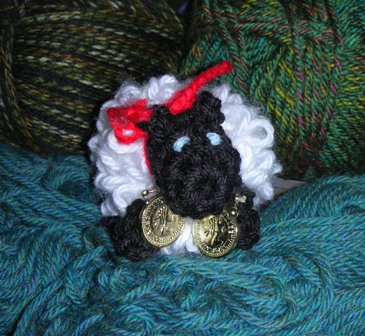
In Mexico many families place a small toy sheep behind their door on New Year’s Day to ensure prosperity throughout the year. Today, these small effigies are often commercially purchased and made of plastic with synthetic “wool” stuck to the sides and a red thread (for luck) strung with gold plastic coins tied around the neck; but some sheep are knit or sewn.
Lana, the Spanish word for “wool” is also a slang term for “money” in Spanish, much the way we might use the word “dough” in English. The origins for this usage may date back to Medieval Spain. Between the 13th and 18th centuries Spain held a monopoly on Merino sheep, which proved so vital to the economy that it was forbidden to export the sheep without royal permission.
The Spanish introduced sheep to the Americas in 16th century, eager to teach the indigenous people to produce the woolen garments the Spanish were accustomed to and also to widen both their productive base and their market for woolen goods..
The word for sheep in Nahuatl, the language of the Aztecs, is the same as their word for cotton: ichcatl; a testament not only to the similar physical resemblance they bear, but also the similar purpose they served.
A Crocheted Lucky Sheep Pattern
Materials:
Worsted weight yarn in white and black (I used acrylic from my stash, but Merino wool would be the natural choice!)
Size G crochet hook, or what works with your yarn, gauge is not important for this pattern.
Fiber of choice for stuffing the sheep (cotton balls, wool roving, commercial batting etc)
Needle and embroidery thread for eyes.
Optional: Red thread or ribbon and plastic coins to tie around the neck.
Abbreviations:
Ch- chain
St- Stitch
Sc- single crochet
Dec- Decrease, work the next two stitches together
Lp st- loop stitch: Work as you would a normal single crochet stitch, but wrap the yarn held at the back of the work tightly around your finger (or a knitting needle, or cylindrical object of choice) to form the “loop” and hold it apart before inserting the crochet needle into the next stitch to produce your second loop for a regular sc stitch. You will now have one large loop at the back of the work and two small loops at the front. Work these two loops at the front together as you would a normal single crochet stitch.
The following websites have loop-stitch tutorials:
http://www.crochetme.com/loop-stitch-tutorial
http://www.nexstitch.com/v_loop_stitch.html
Head:
Chain 3 sts, join. Work 6 sc in ch3 loop, join.
Place marker, 2sc in each st around (12 st).
Sc in each st around for 3 more rows
Dec, each stitch around (6 stitches)
Stuff head.
Select position for ear and sc in st, ch3 and sc in same stitch.
Repeat for the other ear.
Eyes: With needle and embroidery thread, sew small wrapped stitches or French knots for eyes.
Body:
With the wrong side facing (the head facing away from you) and white yarn, sc into each of the 6 stitches around the base of the head. For the next round, increase the number of stitches by working 1 sc and 1 lp st, into every st (12 sts).
Then increase every other stitch by working 1sc and 1 lp stitch in the next stitch and 1 sc only in the next stitch after that. Repeat around for a total of 18sts.
Work 6 rows even, working every stitch as a lp st.
Decrease every around by working two stitches together maintaining the lp st around (9 sts)
Stuff body. Work another decrease round. Cut thread and pull through remaining 5 stitches to close the opening.
Legs:
With black thread, ch 4, turn and sc in each stitch. Fold the chain in half and attach the leg to body of the sheep. Repeat 3 more times.
Tie a red thread and small coins around the neck if desired.




Leave a comment
Comments feed for this article